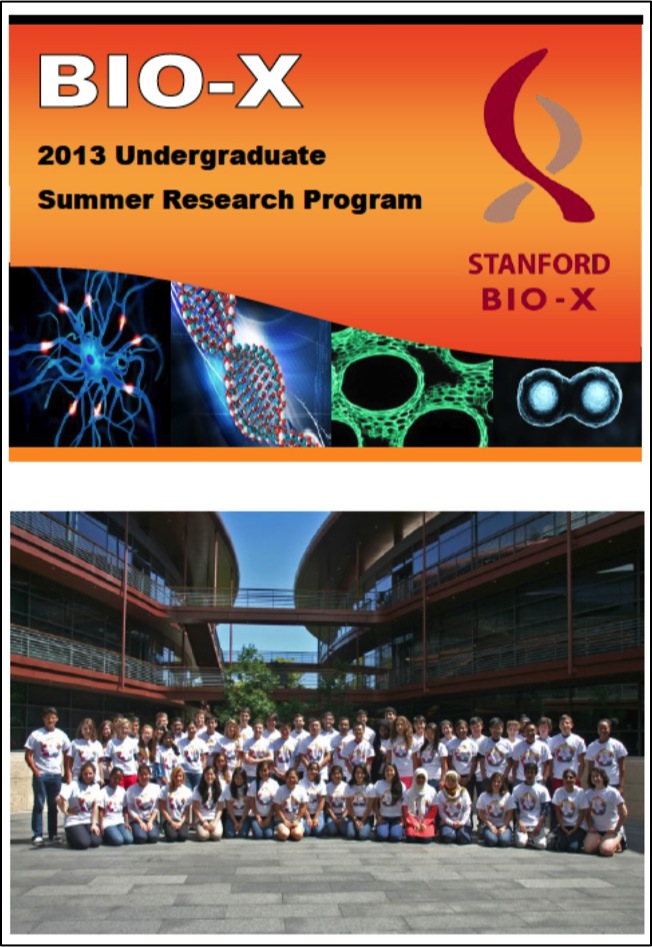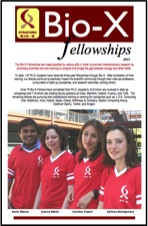
Welcome to the biweekly electronic newsletter from Stanford Bio-X for members of the Bio-X Corporate Forum. Please contact us if you would like to be added or removed from this distribution list, or if you have any questions about Stanford Bio-X or Stanford University.
On October 9, 2013, Bio-X celebrated the 10th Anniversary of the James H. Clark Center, the hub of Bio-X. Check out CLARK CENTER @ 10X on the SPLASH PAGE as well as the Bio-X Timeline over the last 15 years!!
Seed Grants
 SEED GRANTS FOR SUCCESS - Stanford Bio-X Interdisciplinary Initiatives Program (IIP)
SEED GRANTS FOR SUCCESS - Stanford Bio-X Interdisciplinary Initiatives Program (IIP)
The Bio-X Interdisciplinary Initiatives Program represents a key Stanford Initiative to address challenges in human health. The IIP awards approximately $3 million every other year in the form of two-year grants averaging about $150,000 each. From its inception in 2000 through the fifth round in 2010, the program has provided critical early-stage funding to 114 different interdisciplinary projects, involving collaborations from over 300 faculty members, and creating over 450 teams from five different Stanford schools. From just the first 5 rounds, the IIP awards have resulted in a 10-fold-plus return on investment, as well as hundreds of publications, dozens of patents filed, and most importantly, the acceleration of scientific discovery and innovation.
In 2012, Stanford Bio-X selected 23 new seed grant projects as the winners of the 6th round. Please go here to view the list of awardees, along with the titles of their projects and the abstracts of the research. Competition was intense as the awardees were chosen from 118 Letters of Intent (LOIs). Selection criteria included innovation, high-reward, and interdisciplinary collaboration. (To view the 114 other IIP projects that have been funded from the first 5 rounds, please click here.) In addition, SANOFI has also funded 4 new Bio-X IIP Seed Grant projects from round 6!
On Monday, August 26, 2013, Bio-X had its second annual IIP Symposium of the year at the Clark Center, which highlights projects that exemplify the Stanford Bio-X mission of crossing boundaries to bring about interdisciplinary research and solutions in the field of life bioscience. The symposium was a huge success with over 300 people attending this event, which included 8 oral presentations and 136 poster presentations. Recorded talks from the symposium will be uploaded soon. If you'd like to view the talks for previous symposia through the years, please click here.
We are cultivating and are highly successful in building meaningful collaborations with numerous corporate colleagues. New collaborations through our seed grant projects are highly encouraged. To learn about how to get involved, please contact Dr. Hanwei Li or Dr. Heideh Fattaey.
Fellowships
Every year, graduate students and postdoctoral scholars of Bio-X affiliated faculty are highly encouraged to apply for the Bio-X Fellowships, which are awarded to research projects that are interdisciplinary and utilize the technologies of different fields to solve different biological questions. Students are encouraged to work collaboratively with professors of different departments, thus creating cross-disciplinary relationships among the different Stanford schools. Our fellows have conducted exciting research, resulting in publications in high-impact journals and have been offered excellent positions in industry and academia. To date, Stanford Bio-X has a total of 152 Fellows.
On June 26th, Bio-X held its annual Bio-X Fellows Symposium, where there were four 15-minute oral presentations followed by one-minute spiels from current fellows. The 25 newest fellows selected this year were also announced, and about 100 attendees came to the symposium. Please click on the "Bio-X Fellows Symposium" link above for the agenda and titles of the talks, and on the icon of the brochure above for the updated and latest Bio-X Fellowships brochure.
To view the numerous projects that have been awarded over the years, please click here.
 BIO-X UNDERGRADUATE SUMMER RESEARCH PROGRAM
BIO-X UNDERGRADUATE SUMMER RESEARCH PROGRAM
The Bio-X Undergraduate Summer Research Program supports undergraduate research training through an award designed to support interdisciplinary undergraduate summer research projects. The program is an invaluable opportunity for students to conduct hands-on research, learn how to carry out experiments in the laboratory, and develop the skills to read and analyze scientific literature.
This program is eligible to Stanford students who want to work in the labs of Bio-X affiliated faculty. To date, 241 students have been awarded the opportunity to participate in the Bio-X Undergraduate Summer Research Program. This summer is Stanford Bio-X's 8th round of USRP.
Participating undergraduates are also required to present poster presentations on the research that they've conducted during the program. Please click here for title lists of past posters that our undergraduates have presented.
Many fruitful collaborations and relationships have been established with industry through fellowships. Please contact Dr. Hanwei Li or Dr. Heideh Fattaey if you'd like to learn more about how to get involved with these fellowship programs.
News

 Research confounds previous view of how brain sorts sensory information in decision making
Research confounds previous view of how brain sorts sensory information in decision making
Bio-X NeuroVentures Director Bill Newsome and Bio-X Affiliated Faculty Krishna Shenoy
While eating lunch, you notice an insect buzzing around your plate. Both its color and motion may influence how you respond. If the insect is yellow and black — the colors of a bee — you might retreat. Conversely, you might simply be annoyed at the buzzing motion and shoo the insect away. You perceive both color and motion and decide based on the circumstances. Our brains make such contextual decisions in a heartbeat. The mystery is how they do so. In an article published Nov. 7 in Nature, a team of Stanford neuroscientists and engineers delve into this decision-making process and report some findings that confound the conventional wisdom. Until now, neuroscientists believed that decisions of this sort involved two steps: One group of neurons would perform a gating function to ascertain whether motion or color was most relevant to the situation, and a second group of neurons would consider only the sensory input relevant to making a decision under the circumstances. But in a study that combined brain recordings from trained monkeys and a sophisticated computer model based on that biological data, William Newsome, PhD, professor of neurobiology, and three other researchers discovered that the entire decision-making process may occur in a localized region of the prefrontal cortex.
 Quantity, not just quality, in new Stanford brain scan method
Quantity, not just quality, in new Stanford brain scan method
Bio-X Affiliated Faculty Brian Wandell
Imagine that your mechanic tells you that your brake pads seem thin, but doesn't know how long they will last. Or that your doctor says your child has a temperature, but isn't sure how high. Quantitative measurements help us make important decisions, especially in the doctor's office. But a potent and popular diagnostic scan, magnetic resonance imaging (MRI), provides mostly qualitative information. An interdisciplinary Stanford team has now developed a new method for quantitatively measuring human brain tissue using MRI. The team members measured the volume of large molecules (macromolecules) within each cubic millimeter of the brain. Their method may change the way doctors diagnose and treat neurological diseases such as multiple sclerosis. "We're moving from qualitative – saying something is off – to measuring how off it is," said Aviv Mezer, postdoctoral scholar in psychology. The team's work, funded by research grants from the National Institutes of Health, appears in the journal Nature Medicine.
 Work by Stanford chemical engineers could lead to greener fuels, fertilizers and petrochemicals
Work by Stanford chemical engineers could lead to greener fuels, fertilizers and petrochemicals
Bio-X Affiliated Faculty James Swartz
Making hydrogen easily and cheaply is a dream goal for clean, sustainable energy. Bacteria have been doing exactly that for billions of years, and now chemists at the University of California, Davis, and Stanford University are revealing how they do it, and perhaps opening ways to imitate them. A study published Oct. 25 in the journal Science describes a key step in assembling the hydrogen-generating catalyst. "It's pretty interesting that bacteria can do this," said David Britt, professor of chemistry at UC-Davis and co-author of the paper. "We want to know how nature builds these catalysts. From a chemist's perspective, these are really strange things." The results reported in Science build on years of chemical engineering and bioengineering groundwork. “Our lab here at Stanford has spent a decade working with these enzymes, and this allowed us to produce the samples required for these studies,” said James Swartz, the James H. Clark Professor in the School of Engineering at Stanford, and a member of the research team.
Events
| Neurology & Neurosciences November 15, 2013, 8 am - 9 am 300 Pasteur Drive, LKSC-130, Stanford, CA "Homeostatic Control of Oligodendrocyte Progenitors in the Adult CNS" Speaker: Dwight Bergles, PhD, Johns Hopkins School of Medicine |
Biology November 18, 2013, 4 pm - 6 pm 393 Serra Mall, Herrin T-175, Stanford , CA "Genomic mechanisms of chromatin organization and transcription initiation" Speaker: Frank Pugh, Pennsylvania State University |
| Neurosciences Institute November 21, 2013, 12 pm - 1 pm Clark Center Auditorium, Stanford, CA "Potentiated protein disaggregases to combat neurodegeneration" Speaker: James Shorter, PhD, Univ of Pennsylvania |
Bio-X Frontiers in Interdisciplinary Biosciences Seminar November 21, 2013, 3:15 pm - 4:15 pm Clark Center Auditorium, Stanford, CA "Itch Mechanisms" Speaker: Xinzhong Dong, Johns Hopkins University |
Resources
| Stanford University |
| Stanford Bio-X |
| Bio-X Seed Grants The Stanford Bio-X Interdisciplinary Initiatives Program (IIP) provides seed funding for high-risk, high-reward, collaborative projects across the university, and have been highly successful in fostering transformative research. |
| Office of Technology and Licensing "Techfinder" Search the OTL Technology Portal to find technologies available for licensing from Stanford. |
| Stanford Center for Professional Development - Take advantage of your FREE membership! - Take online graduate courses in engineering, leadership and management, bioscience, and more. - Register for free webinars and seminars, and gets discounts on courses. |
| Stanford Biodesign Video Tutorials on how FDA approves medical devices A series of video briefs recently produced by the Stanford Biodesign Program teaches innovators how to get a medical device approved for use in the United States. This free, online library of 60 videos provides detailed information on the Food and Drug Administration regulatory process, short case studies and advice on interacting with the FDA. |
To learn more about Stanford Bio-X or Stanford University, please contact Dr. Hanwei Li, the Bio-X Corporate Forum Liaison, at 650-725-1523 or lhanwei1@stanford.edu, or Dr. Heideh Fattaey, the Executive Director of Bio-X Operations and Programs, at 650-799-1608 or hfattaey@stanford.edu.


